
-
Find the right food for your petTake this quiz to see which food may be the best for your furry friend.Find the right food for your petTake this quiz to see which food may be the best for your furry friend.Featured products
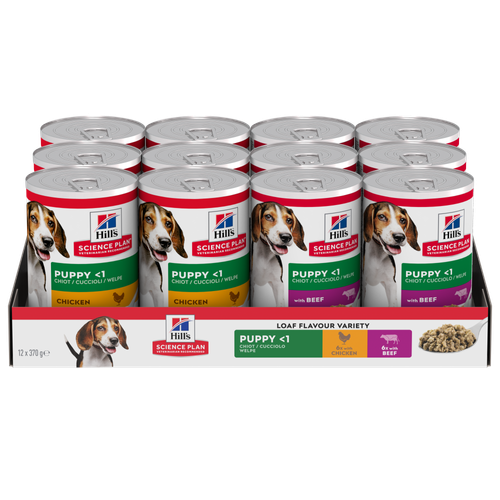 Puppy Food
Puppy FoodHill's Science Plan Puppy Multipack Wet Dog Food with Chicken & Beef are complete premium pet foods for growing puppies from weaning until 1 year old and for pregnant and nursing dogs. Your puppy will love these deliciously smooth and savoury minced loaves, formulated for balanced nutrition and overall health.
Shop Now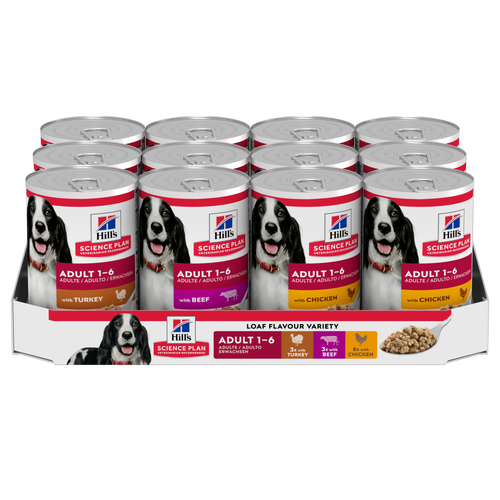 Adult Wet Dog Food with Beef
Adult Wet Dog Food with BeefHill's Science Plan Adult Multipack Wet Dog Food with Chicken, Beef & Turkey are complete premium pet foods for adult dogs from 1 year. Your dog will love these deliciously smooth and savoury minced loaves, formulated for balanced nutrition and overall health.
Shop Now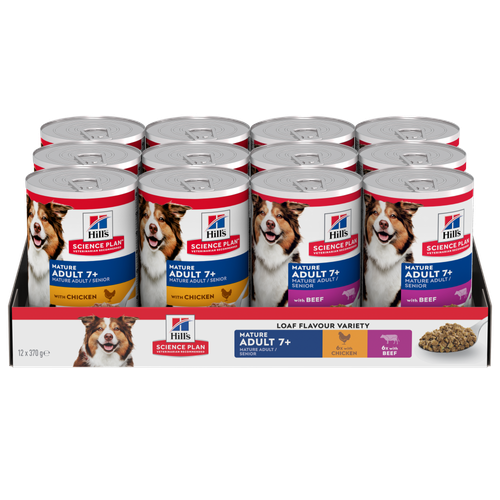 Mature Adult Dog Food
Mature Adult Dog FoodHill's Science Plan Mature Adult Multipack Wet Dog Food with Chicken & Beef are complete premium pet foods for mature adult dogs from 7 years. Your dog will love these deliciously smooth and savoury minced loaves, formulated to deliver the appropriate amount of energy to support the needs of adult dogs.
Shop NowFeatured products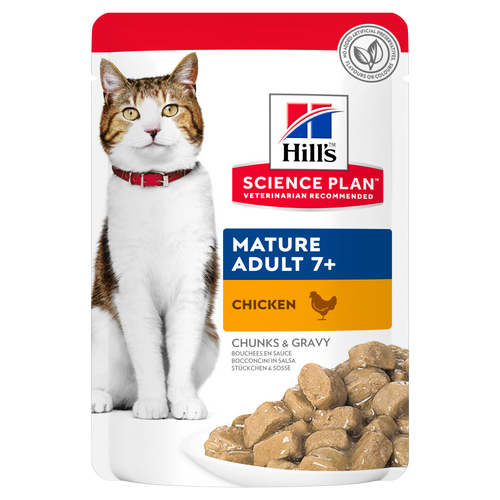 Mature Adult Wet Cat Food with Chicken
Mature Adult Wet Cat Food with Chicken
Tender chicken chunks in gravy for mature adult cats. Made with easy-to-digest ingredients, high-quality protein for lean muscle maintenance and antioxidant vitamins C+E for optimal health.
Shop Now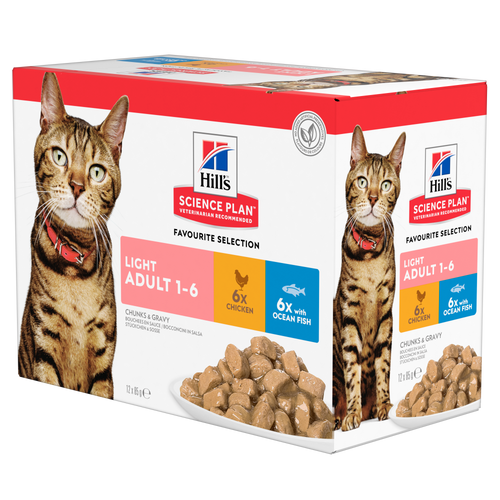 Light Adult Multipack Wet Cat Food with Chicken & Ocean Fish
Light Adult Multipack Wet Cat Food with Chicken & Ocean FishTender chicken chunks in gravy for cats, with L-carnitine and fewer calories for ideal weight management. Packed with high-quality protein, omega-6s, and vitamin E for shiny fur and healthy skin.
Shop Now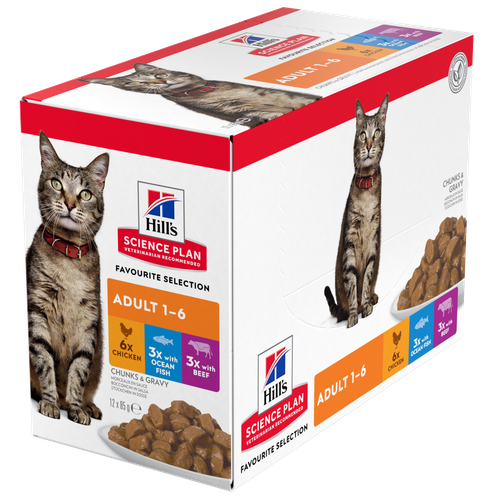 Adult Multipack Wet Cat Food with Beef, Ocean Fish & Chicken
Adult Multipack Wet Cat Food with Beef, Ocean Fish & ChickenTender chunks in gravy for cats, with high-quality protein to maintain lean muscle. With vitamin E and omega-3s & -6s for healthy skin and balanced minerals to support healthy vital organs.
Shop Now -
Dog
- Dog Tips & Articles
-
Health Category
- Weight
- Food & Environmental Sensitivities
- Urinary
- Digestive
- Joint
- Kidney
-
Life Stage
- Puppy Nutrition
- Adult Nutrition
- Senior Nutrition
Cat- Cat Tips & Articles
-
Health Category
- Weight
- Skin & Food Sensitivities
- Urinary
- Digestive
- Kidney
-
Life Stage
- Kitten Nutrition
- Adult Nutrition
Featured articles The Right Diet For Your Pet
The Right Diet For Your PetIn people, the right diet is very important. If you are eating the wrong way for your metabolism, activity level, age and lifestyle you could end up with health issues.
Read More The Incredible Science Behind Your Pet's Microbiome
The Incredible Science Behind Your Pet's MicrobiomeLearn what your pet's microbiome is, how it contributes to your pet's gut and overall health, and why nutrition is important in maintaining healthy microbiomes.
Read More Show some love with wet foods: a great choice for pets with health issues
Show some love with wet foods: a great choice for pets with health issuesShow some love with wet foods: a great choice for pets with health issues.
Read More -


Your garden should be a safe, fun haven for the whole family, including your dog. This outside space is a place to play with your dog, let them explore, and have some stimulation when you’re busy, and for everyone to relax, enjoy those peaceful moments, and watch the world go by for a moment. But your garden can also be a bit of a minefield of dangers for an inquisitive furry friend, so you’ll want to be sure that your garden is dog-proof. Let’s look at what some of those dangers are and how you can get peace of mind by dog-proofing your garden.
Common dangers in the garden
The most common dangers for dogs that lurk in your garden are plants, chemicals, tools, sheds or greenhouses, water features and fencing. Let’s have a look at them one at a time.
Plants
Many common plants can be poisonous to dogs, and some are fatal. If your dog is tempted to root out a bulb, for instance and start chomping away, stop them; they're very dangerous. Here are some other plants that are toxic to dogs, in some cases severely so: foxglove, primrose, yew, ivy, rhubarb, wisteria, lupin, sweet peas, poppy, chrysanthemum, and laburnum. You can find more information about poisonous plants on the PDSA website.
Try to make sure you know what these plants look like and either remove them or barricade them off with some good quality fencing that’s an appropriate size for your dog. If you see odd behaviour or signs after your dog’s been out in the garden, call your vet. These could include vomiting, staggering, drooling or seizures, among others.
Chemicals
We do love our gardens to be beautiful places, free from pests with nice furniture and fences. What you may not realise is that any commonplace garden products can be dangerous and sometimes fatal to dogs. Slug pellets and rodent poisons are especially toxic, as are some insecticides and weed killers. Read the instructions carefully and above all, keep these products well out of reach of your dog. You will also need to be extremely careful about things like wood preservatives; keep your dog indoors until they are properly dry and be very careful to mop up spills. If your dog is unlucky enough to come into contact with something harmful, or you only suspect they have, contact your vet immediately.


Tasty Tips
Tools, sheds and greenhouses
If your dog is playing in the garden, never use a lawn mower or strimmer as these can cause serious injuries. Never leave tools with sharp blades and points lying around; if your dog stands on one, they can be badly injured. And to protect you from getting a soaking, don't leave the hose out for them to chew on!
Be aware of sheds and greenhouses and always keep them shut if your dog is in the garden. Sheds and garages are where we most commonly store the most dangerous items for our pets. Dogs will often love to creep into a greenhouse because it’s so beautifully warm, but if they get trapped inside they could very quickly get heat stroke and this can be rapidly fatal, just the same as being left in a car on a hot day.
Water features
Make sure your water features and ponds are covered, especially while your dog is young. They could have trouble getting out of the shallowest water and injure themself or drown. Green algae that commonly grows in ponds is also a potential cause of illness in dogs that might be tempted to have a drink or a wallow in your pond. Always make sure there is plenty of fresh water available when your dog is out in the garden.
Fencing
One of your garden jobs should be to check that your fencing is dog-proof before they can be let out and preferably before your dog joins the family. The last thing you want is for your furry family member to get lost or injured on the roads. Good quality fencing is essential if you want a properly dog-proof garden. Even if you have a substantial hedge, dogs can squeeze through surprisingly small gaps, especially if they are small dogs already! A robust fence needs to be free from gaps and high enough that your dog can’t jump out. They can be quite springy when they want to go for a walkabout on their own! There are also lots of companies that specialise in pet-specific fencing. These can be useful for keeping your dog in, but also for keeping other animals out that might fight with your dog and cause injury. Please don’t use electric fences or collars that give shocks to keep your dog contained. These devices simply hurt your dog, cause fear and ruin your friendship.
And finally…
Don’t worry too much! This might make it sound like your garden is a veritable death trap, but with some forward planning and little work, you can very easily make your garden a dog-proof haven that you and your dog can both make the most of. Enjoy it!
Reviewed by Dr. Hein Meyer, DVM, PhD, Dipl-ECVIM-CA and Dr. Emma Milne BVSc FRCVS


One of our staff authors prepared this article for you
Related products

Hill's Science Plan Mature Adult Multipack Wet Dog Food with Chicken & Beef are complete premium pet foods for mature adult dogs from 7 years. Your dog will love these deliciously smooth and savoury minced loaves, formulated to deliver the appropriate amount of energy to support the needs of adult dogs.

Hill's Science Plan Puppy Multipack Wet Dog Food with Chicken & Beef are complete premium pet foods for growing puppies from weaning until 1 year old and for pregnant and nursing dogs. Your puppy will love these deliciously smooth and savoury minced loaves, formulated for balanced nutrition and overall health.
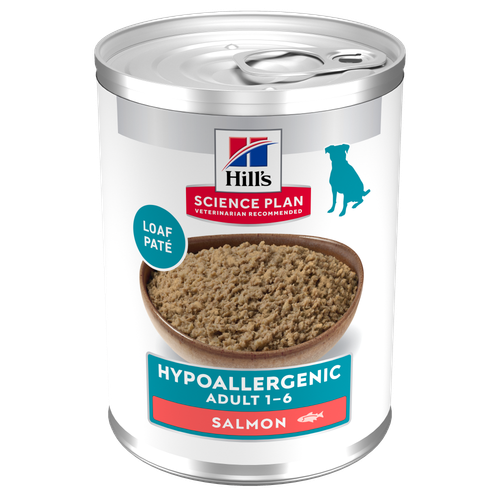
Hill's Science Plan Hypoallergenic Adult Wet Dog Food with Salmon is a complete premium pet food for all adult dogs from 1 year. This savoury tinned loaf is specially formulated for dogs with delicate skin and stomachs. It features a single novel animal protein source and is grain-free.

Hill's Science Plan Adult Multipack Wet Dog Food with Chicken, Beef & Turkey are complete premium pet foods for adult dogs from 1 year. Your dog will love these deliciously smooth and savoury minced loaves, formulated for balanced nutrition and overall health.
Related articles

How, when and what to feed your new puppy is an important decision, learn more about the things to consider for feeding your puppy.

Learn about the potential health risks of a raw diet for dogs and why they aren't the best option for your pup or you.

Many human foods are dangerous to dogs. Read about 5 of the worst toxic food offenders that can kill your dog - and how much it takes to hurt them.

Learn effective tips for feeding a dog that's a picky eater and ensure proper nutrition for a finicky eater. Discover tips for pet parents at Hill's Pet UK.

Put your dog on a diet without them knowing
Our low calorie formula helps you control your dog's weight. It's packed with high-quality protein for building lean muscles, and made with purposeful ingredients for a flavourful, nutritious meal. Clinically proven antioxidants, Vitamin C+E, help promote a healthy immune system.
Put your dog on a diet without them knowing
Our low calorie formula helps you control your dog's weight. It's packed with high-quality protein for building lean muscles, and made with purposeful ingredients for a flavourful, nutritious meal. Clinically proven antioxidants, Vitamin C+E, help promote a healthy immune system.

